Gus's Musings
July 2, 2014
Sometimes when individuals or groups offer some food/fibre that has “special” qualities, other producers feel as though they are saying “everyone else does a poor job”, that isn’t what I hear at all. When I hear a beef producer selling (for example) “ethically produced beef”, I don’t feel they are saying that I don’t produce beef ethically. They are simply saying that “we feel very strongly that beef should be produced ethically, we are good at it and we are proud of it”.
I think it is fantastic that farmers are prepared to market their strengths and receive rewards for their skills by connecting them with consumers that have similar values. At the same time they are setting benchmarks that the rest of us can aspire to and aim for in order to improve the way we produce our wonderful products.
At Wyndham we have very strong values around the land, we look to manage our animals in harmony with the landscape. As we are managing our farm respecting our values, we are happy as well, making for a happy healthy farm. As most farms have different values it is important that each sets their own benchmarks, we try not to compare ourselves to our neighbours, setting our own standards or goals.
There are plenty of “dream crushers” out there saying that our goals are unachievable or totally unrealistic for our region, most of the time they are just placing their standards or paradigms on us, instead of respecting ours.
It is so important that we encourage many farmers to build on their strengths and where possible market them, then they promote the skills they have raising the bar for all the rest of us in the industry. This is R&D at ground root level, the best type as it is so transferable from farmer to farmer.
So next time you hear someone in your industry marketing their area of expertise, encourage them and learn from them as they may hold the key to your farm improving.
June 22, 2014
Monday 4th of August 9am start
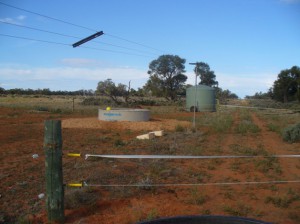
Cell watering point
Would you like to look around a pastoral property set up with water cells for grazing management that has been rotationally grazing for 12 years?
We would welcome everyone to Wyndham to look around and discuss issues that concern them with running a grazing property.
· What goals have you set for your landscape, Livestock or People?
Where we go on the day and what we discuss will be directed by who is there.
· How can you place a value on the landscape when you only get paid for the produce?
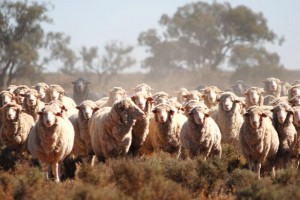
Ewes all in the landscape
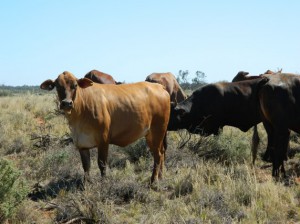
Happy livestock in a happy Landscape
The day will be facilitated by Grahame Rees.
RSVP 31/07/2014 BYO chair, drinks and food to share
For more information contact Angus on Ph 0350270230 or
email wyndham3@bigpond.com
June 8, 2014
We know about climate change and a change in the weather, what is different to a change of farming systems?
I want to talk about “change”, to some this word is scary to say the least, while to others it is exciting. There is lots of talk about how farming needs to change to become more sustainable, or to produce more for 9 billion people or even to cater for the change in peoples diets. Some may say that there has been significant change in agriculture over the last 50 years and there has been in components of our industry, a lot of changes are really about making what we do easier. Take for instance the grazing industry, there has been more mechanisation, using planes/helicopters, better watering systems, shedding sheep, live export; these changes have all meant we can reduce labour/costs so we can continue grazing stock. Now this isn’t saying that agriculture is bad, it is more about where is agriculture going?
I see the main reason that Agriculture (Ag) hasn’t seen much change isn’t because farmers are out of touch or uncaring, the main reason is that nothing is driving change and there isn’t a clear direction of where farming/land management is going. We depend on economic signals to direct Ag as we have done for a long time, so with the declining terms of trade (and fixed wages) the directive has been to increase scale, seeing a reduction in the number of farmers, that is still occurring.
Humans are the same as all animals to have change on a large scale (herd) there needs to be a clear direction that leaders can head towards, given support, guidance and encouragement. There also needs to be pressure from behind as most animals move away from pressure, this can be economic, environmental, peer pressure or legislation. Without a clear direction, leaders go off in a multitude of directions giving very confused signals to the rest of the group. After a while peer group pressure means everyone gets brought back to the average and it takes enormous energy and courage to shift away from the norm.
With the continued reduction in farmers that has been occurring over the last 30 years, effectively the Ag community has been culled down to the most resilient/stoic few. The farmers that we have now are very independent and they don’t look for leadership, they continue doing what they do best in order to make sure they aren’t the next to exit the industry. So we don’t have so much as a group of farmers, more a group of individuals that are extremely resourceful and staunchly independent.
We have had mobs of livestock turn up in exactly this frame of mind and we have done a lot of work with them to make sure they work as a mob of interdependent animals, this only can come about through the use of kindness.
So if we would like to see Ag change to become more sustainable, or to change for dietary habits then we need to set clear directions, put in place some clear drivers and legislative support and importantly show kindness and compassion, as we should to all.
March 31, 2014
This review was written by me in 2009 after I had first read the 2 books, rip out and grab a copy if you haven’t already read them.
(“Back from the Brink” & “Beyond the Brink” By Peter Andrews)
These two interesting books moved me enough to put something down on paper to encourage others to read them and be challenged by Peter’s ideas and interpretations of the landscape. I’m not going to give a run down on the contents of the books as you will have to read them to capture that, I’ll just give you a taste of some of the concepts that peter deals with.
The first book (Back from the Brink) outlines the way that Peter interprets the landscape and how he has been able to re-invigorate the land on the properties that he has worked with. The second book takes these methods and shows how they can be adapted to deal with some of the biggest land management issues going on in Australia, namely the Murray-Darling system and the salinity in Western Australia. At the same time there are little gems and things that you can do on your own property no matter if you have ¼ ac or 100,000ac.
Some of the challenges thrown to you in the books are: What is the difference between native and introduced plant species? Why do we have to use only native species when rehabilitating an area? Why do you spray out weeds when they may be doing a very important role? Is carbon dioxide the cause of global warming or a symptom?
These are just some of the many challenges thrown out to you, speaking of “thrown” sometimes these challenges were very hard for me to take on board so you do feel like throwing the book against the wall, I guarantee though, that you will go over, pick it up and keep going until the urge grabs you again. Both books are easy to read, you just have to be careful that you don’t miss some of his subtle methods so don’t be frightened to pick up a pencil and jot down ideas and page numbers to go back to them.
As someone who has met Peter Andrews I think that he has an enormous amount to offer land management both in Australia and around the world. He is a very decent person that will happily sit and chat about his experiences for hours and I’d happily listen to him for hours.
Both of these books are available at ABC shops or online just ask for them by name. Enjoy them and I would like to see more people read them so that we can have some really positive ideas for ways forward in land and water management in this country
March 10, 2014
I don’t know how many times I hear people say that “My land shouldn’t be grazed” or “grazing wrecks the land” or even “that land really needs a good graze”. Now all of these statements are correct, and all are absolutely wrong, because grazing isn’t that simple and depends entirely on who is driving the tool!
So let me explain to you how I see grazing, there are two main types, with multiple variations:
- Set stocking: This is when if you say have a 500ha paddock and the conservative carrying capacity of that land is about 1 sheep/ha, then you would put 500 sheep in there for the year, every year. This usually results in very good animal productivity, without always having the flexibility to respect the land.
- Time controlled/rotational grazing: This is when you run larger mobs of stock resting paddocks so that stock are only on a portion of the property at any one time. This can be a very sharp tool that requires good management, normally there is lower individual animal performance, offset by a higher stocking rate.
I would be pretty sure that most properties grazing systems would fit somewhere into these rough two categories. The outcomes of either system or any hybrid in between are extremely dependant on who is “driving” the tool. So why then do people broadly place grazing under 1 banner? I suggest this is done mainly through lack of knowledge and respect for the people that are out there grazing, the farmers. Such a shame when I see so called peer reviewed scientific paper that talks about the damage livestock cause to the land, or the weeds they bring up and so on, when all those involved in putting together the paper have done is thrown away all of their I.Q. by disrespecting others.
I’m yet to hear of a grazing management trial that has been done using experts, i.e. farmers managing the systems, there is no doubt that the outcomes of all grazing management trials have been compromised due to lack of livestock handling and landscape interpretation skills. Enough of worrying what others think of grazing, time to start talking about using grazing to help you.
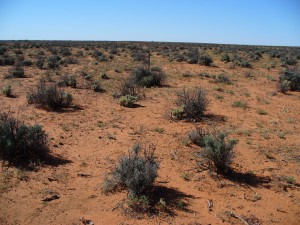
Site 1 Landscape Feb 2008
So when looking to put together a grazing management system in harmony with the land, you need to first understand what you have and be prepared to take responsibility for the current condition of you land/farm. Then you set yourself some goals, I prefer to set a pathway with no end so I can keep reaching for the stars. Once you have a clear direction you make up an inventory of all the resources at your disposal, before finding the best way to utilise them in order to start moving in the right direction. An example of the resources would be: cash, people, services, machinery, other?
This way you can put together a grazing system that not only meets your needs, it also respects your land, the people, the livestock and the business. So if you think that grazing won’t work on your place, maybe you should see some of the wonderfully skilled operators out there that could graze any land to improve it, while making stock and people happy & healthy and even money in the bank!
Remember grazing can be the sharpest tool in your tool box that you can’t go without or it can be a blunt bit of wood that lies around, no value to anyone, burn it, get rid of it, you and you alone will be responsible for either outcome!!
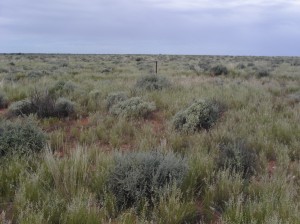
Site 1 Landscape Feb 2011
February 2, 2014
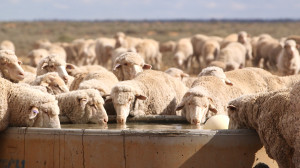
Animal welfare is such an emotive issue in farming, it can tear at the heart strings of large parts of our community, causing anger & division to name a couple of the raw emotions involved. I certainly don’t plan to resolve this in a few words here, as much as I would love to, this is more about giving our perspective so you can understand how we view this important issue. So to explain our perspective, firstly I’ll break it up into three areas; Animal nutrition, health & wellbeing, then livestock handling, finally I’ll bring these together to show how we see animal welfare fitting in with the other components of running a farm.
Animal Nutrition:
When we take on the role of animal carers we “sign a contract” to always provide adequate nutrition (including water) to those animals in our care. With water, stock may not need water constantly, just when they wish to have a drink water must be there, not negotiable. If this water “contact” is broken it can result in stock losing (or just not gaining) weight for a period of weeks.
Now we view adequate nutrition as not only quantity, quality and diversity as well. In order to maintain good nutrition and health & wellbeing a diverse range of foods should be available so that animals can “self medicate” for many health issues, such as worms & other internal parasites, for example. Just allowing stock to have large quantities of good quality feed that may be made up of just a couple of species won’t allow for this, supplementing with minerals, vitamins etc. assists, just can’t replace the value of whole foods. If we can enable our livestock to have a range of foods available, they can fulfil their requirements; this in turn makes them very healthy food for us.
Animal nutrition isn’t about having stock fat or putting on huge weight gains per day, it is about being healthy so that animals can reproduce & defend themselves from disease and predators.
An important part of livestock nutrition is good livestock handling, this will result in the animals being comfortable in their surroundings and able to make the most of their nutrition.
Health & Wellbeing:
Health & wellbeing shouldn’t be about keeping up drenching, vaccinations, dipping etc. like it seems to be in our current culture. Good health for livestock should be about enabling them to help themselves as stated above. We also believe that predators have a role to play in the landscape so animals need to be able to protect themselves, part of this is encouraging herding instinct and strengthening family ties in breeding animals.
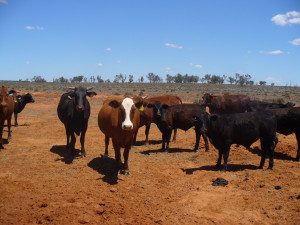
Livestock Handling:
This is a fairly contentious area as the current thinking with the way we do things in society is that we must have a policy, a plan of how the livestock will be handled. We almost NEVER EVER PLAN, we only focus on outcomes. The reasoning behind this is that we never know the state of mind of the livestock we will be working with until we get in the paddock/yards with them, we may have to work them for a while until you “connect” with them so that we can draft, shift or whatever we need to achieve with them. So we value being able to work our stock in a manner that causes neither us nor the livestock too much discomfort. This was brought to our attention when we attended a Low Stress Stockhandling school about 10 years, up until then we didn’t know how effortless handling stock could be.
Over the years we have developed our own techniques of handling livestock, so they know just by the intent we take when handling them, what they need to do. They can tell when we are just checking waters, as opposed to being mustered or shifted into a new paddock. They are comfortable in their surrounds because we respect their space and their needs, while at times taking on the role of “predator” to encourage the herding instinct & keep them connected.
We have bought many stock in over the last ten years, while the flightiest have come from pastoral WA, mainly due to not being handled very much. They were well prepared for the journey, with lots of electrolytes, so that after the trip from WA they hopped out of the truck, none down and we were able to put them on feed settling them down quickly. The most out of control livestock came from western Vic, due to being handled a lot, just very poorly! Another part to their story was our truckie asked for the heifers to be off water for 16 hours prior to travelling, the farmer knew better, he had them still on water! After 6 hours in the truck the stock couldn’t stand up with all the muck in the truck, so the truck had to be washed out before they arrived. Well they were covered in muck, extremely stressed and 1 was down for 24 hours after unloading, the worst possible start and all because stock were poorly prepared for the journey, by people thinking they were looking after animal welfare.
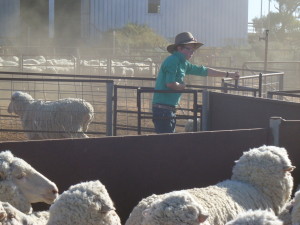
How does Animal Welfare fit into our Management?
As you can see that we value animal welfare enormously in our management, it is a key component and helps us to manage our landscape better. We try and request that people that work our stock do so while respecting our stock, sometimes this may mean asking someone to sit out for a bit or getting a stock agent to sit in the car until we finish.
As our focus is on landscape management rather than livestock management, livestock are an important tool for us, they help us manage the landscape and we sell them and/or their fibre to pay our bills. With this in mind there are times when our stock are on “rations”, they might be on low grade food diet just enough to maintain them so that we can invest some of their energy into management of our landscape. Using the stock in this way enables us to rehabilitate say eroded land and restore ecosystem function, then bring it back into production.

Closing Message:
Livestock are wonderful and can cope with many different circumstances, just so long as they are properly mentally and physically prepared and those caring for them have a “connection” and can understand their needs. Good livestock handlers are able to think like livestock, as opposed to thinking they know what livestock want.
How good is your connection to animals?
December 4, 2013
As a livestock farmer our definition of a drought is: “When your stocking rate exceeds your carrying capacity”. Now surely drought is linked to rainfall isn’t it? Yep low rainfall produces reduced pasture growth, which certainly reduces your carrying capacity a lot and if you are unable/unwilling to destock adequately you will be in drought. Also you are able to induce a drought by continually having a higher stocking rate than your carrying capacity. Using this thinking we are 100% responsible for droughts on Wyndham!
So armed with this knowledge the way to manage our farm is to be able to destock adequate stock when it is dry so that we don’t exceed our lands carrying capacity. While this may sound simplistic, this is the way we choose to manage and part of that is in our principles that everything that happens on our land we are responsible for, without any control over the rain we can only manipulate our stock numbers.
So out of this you would think it is only the landholder responsible for drought, when really the whole community needs to take some responsibility as well. I mean it is a major side step to import food in order to avoid prices rising when droughts reduce supply, or to through pricing encourage farmers to continue trying to produce more than their land is capable so they can financially survive. I think that drought is such a significant issue that while farmers are primarily responsible, everybody is responsible for supporting them so that good long term decisions can be made.
I reckon we should be looking at putting a value on Natural Capital, as our current drought management systems seem to keep seeing the productive capacity of the landscape decline after significant droughts (This is the case in the Western Division of NSW anyway). When we bought Wyndham we assumed that 90% of our Natural Capital had gone, gee this opened up some opportunities for us to improve what we do and improve our landscape, if we only recapture 50% back, have we failed?
You can’t plan for a drought when you are in one, so for those currently in drought our community should do all we can to help, importantly the people, their land and their animals as well Here are some of the things we try and do when in a drought:
- Lean on your network: Contact your friends more often make sure they understand your exact circumstances, this is for your key business partners as well.
- Have a holiday: Just get off the farm for a couple of days, no $ required, camp by a river, on a friends place, whatever get off the farm, it will help you make good quality decisions.
- Home oasis: Make sure you are able to keep the home yard fresh and alive, this too helps with state of mind and good quality decisions, we have reduced our stock numbers just to keep our garden alive.
- Training & Education: As there is less stock it is a good opportunity to seek some training and read some books so you are again in a great state of mind to get the business rolling come rain => grass
- RUOK: Make sure that you keep an eye on your loved ones and also your neighbours, organise some BBQ’s or just a dinner to keep all positive.
- Plan a project: This puts the current situation in perspective as it won’t last, the project will keep your eyes to the future.
- Destock & Restock: When we look at destocking, we see enormous comfort looking at the tail lights of a loaded truck, never any regrets, at the same time we are looking at restocking strategies for when it rains. I remember watching a rally driver roll his car, the camera inside had him going down through the gears waiting for the wheels to hit, then he was off again!
We never ever look to “drought proof” our property as that would be dodging the issue, we prefer to understand it, appreciate it for the opportunities that drought offers, it is where we have made the best land improvements. The multiplier effect of even seemingly small amounts of ground cover is really significant!

- Site 1 Landscape Feb 2008

- Site 1 Landscape Feb 2011
October 21, 2013
When you play a game, do you get caught up looking at the ball? Or do you make sure you watch the game?
It seems that the way we view profit at Wyndham has drawn a fair bit discussion lately, we consider ourselves similar to everybody else, that may or may not be the case. I thought that I would take the time to describe how we view profit so that then you can see how we “roll” at Wyndham.
Now when I mention the word “profit” most people think of money, that is certainly one way to profit, we also look to the environment to profit, the people and even the livestock health. In fact cash profits can be very short term, while environmental regeneration and the health/wellbeing of people are capable of locking in more long-term profit. We view money as fuel for our business and yes that is a resource that needs to be considered when planning, it isn’t as finite as land or people. Another reason we don’t focus on monetary profit is that decision making can very easily compromise the long term profit, by long term I’m not talking 5 yrs, more like 50yrs+.
I have been told by many that economics factors in people, the environment and other associated issues with running a business. Now with my knowledge of complex ecosystems and sciences inability to fully understand the interrelationships involved in them I doubt that very much. So I would consider it inaccurate for an economic value to be put on my health/relationship or the health of our landscape, for example, besides that isn’t the language we speak. Unfortunately an economic value may be required on the landscape so that our society values it, which tells a story about our community.
I love reading about leadership and the qualities/thinking associated with great leaders, now in my reading great leaders spend time improving their core resources (Mainly the people), with the end result being they make more money/returns. So we look at that and say well if we focus on improving our land, making sure the people are right, then money will turn up.
If you have taken a look through our website you will see that we have no specific goal for profitability or money at all and this is a function of our view of it. So with that in mind there is more than a fair chance that we won’t be multi millionaires that is absolutely fine by me. We set our goals around being “pasture growing millionaires”, so if we grow the most productive landscape then we have a major resource.
You might read through this and think that we are just a hobby farm not making much of a profit, more a feel good option. The driver behind us taking this pathway is our strong values and principles as well as our LOW equity levels. By following our values and principles the people are very happy, we all work as effectively as possible and by protecting our physical/human resources we become more of a low risk business.
September 30, 2013
I love watching sport, seeing the best of the best face off and pit themselves against one another to see just who will be the best, it really doesn’t matter what the sport is for me. Whether it is the 100m, where the fastest wins or formula 1 where a combination of the most skilled, fastest & tactically sound, either way it is “benchmarking” who is the best.
Now farming is one of the most benchmarked businesses around, I just wonder if we are measuring the right factors sometimes. Now I have no problem with measuring water use efficiency or stocking rates etc., using these to benchmark with other farmers in the area, I do wonder if benchmarking Return on Investment (ROI) is a valuable overall measure of farmer’s skills. Is it more important that farmers are profitable or they produce the best produce that they can? Or if in fact farmers can produce a wonderful healthy product all the while improving landscape health? So if farming was a sport would we rate ROI as part of the skills required to farm?
Now I’m not suggesting that making money in a farming business isn’t important, I’m questioning if our economic measures are actually rewarding and encouraging the skills we as a community wish to see in our future farmers. I simply see money as a currency used to reward those that fulfill a service, so when I look at farming skills I would like to leave money out of it, just focus on farming. So maybe lets see if I can put a finger on some of the skills I think should be rewarded in order to promote the best possible farmers:
- Best product for the market (based on different market requirements)
- Lowest chemical usage per unit (includes fertilizers)
- Healthiest produce that is good for the land and those eating/wearing it.
- Lowest energy usage (fossil fuels) per unit produced
- Improving biodiversity levels
- Increasing soil health
- Valuable contributors to a diverse community
With the way I look at economic returns, those with some of the highest ROIs (I’m generalizing here), seem to produce a mediocre product at the lowest possible price. So I’m certainly saying that the current system of rewards for farmers encourages mediocrity, which I think is to the detriment of our profession. So if we are serious about encouraging the best possible farmers going into the future I think we need to reward those farmers striving to achieve.
Welcome to the farming Grand Final!!
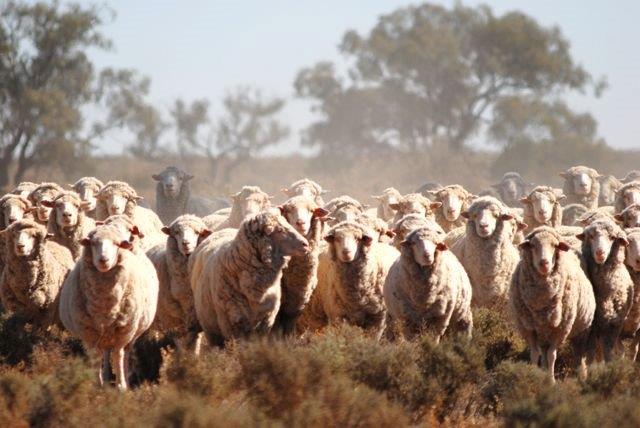
September 8, 2013
I had a note from a very good friend the other day who is very concerned that he reckons the thing most lacking in the food/farming circles is the ability to yarn, respect others opinions, share methods, achievements, without creating any angst.
Now I’m not sure if this comes about because we see most of our so called “leaders” (They are politicians really), spend more time putting those around them down in order that they may be seen as good, rather than just achieving. Maybe it is due to more people feeling insecure, therefore constantly looking for affirmation from their peers. Perhaps it is something to do with time, when time is important maybe we aren’t listening as well as we should or taking the time to relax and just yarn, about stuff!
Either way taking the time to yarn, hear and talk about how, what, when, why someone does something can be enormously beneficial to all involved, especially talking to those that have very different ideas and opinions from you. Now this is an area that I constantly try and improve at because the benefits both personally and business wise can be huge. Below are some points that I hope will help you see the benefits of having more quality yarns and spreading the word:
- You only learn from hearing what you are doing wrong, or listening to those with very different ideas from you
- Make sure that you ask the “right” questions of those that hold a different opinion, always asking those that think the same as you will result in group think.
- Make sure you listen to others, if you would like to have yourself listened too and make sure that you clarify what they have said before making assumptions.
- Never under estimate the “power” of creating relationships, the business opportunities that can come, also the strength and support they can offer when things turn tough, a mental health network.
- I really enjoy the feeling of helping mates out, giving them some advice, them using that to improve. In order for that to happen I need to show that I’m willing to receive advice, act on it and be thankful.
Thanks for hearing my “yarn”, I look forward to many more with you, Cheers!









